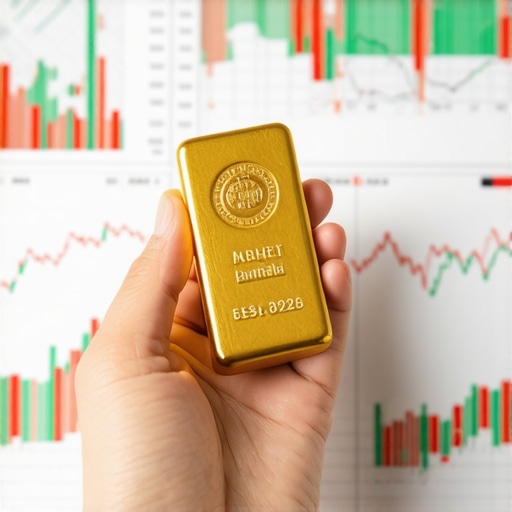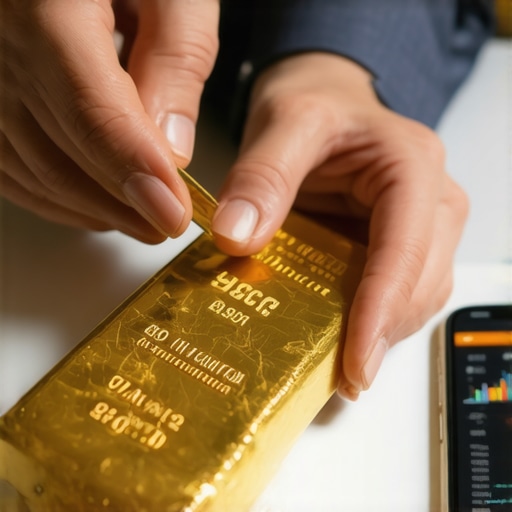Unlocking the Timeless Allure of Physical Gold Investment
In a world where digital assets and volatile markets dominate headlines, physical gold remains a steadfast beacon of wealth preservation. For beginners, the prospect of investing in tangible gold can seem both enticing and daunting. This guide demystifies the journey, offering expert insights into initiating a physical gold investment portfolio that stands resilient against economic uncertainties.
Why Physical Gold? Understanding Its Unique Investment Edge
Unlike paper assets, physical gold offers intrinsic value, a hedge against inflation, and a safeguard during market turbulence. Its scarcity and universal appeal grant it a unique position in wealth protection strategies. However, investing in physical gold requires more than just purchasing; it demands comprehension of purity standards, storage considerations, and market timing.
Decoding Gold Investment Options: Bars vs. Coins
For newcomers, the choice between gold bars and gold coins is pivotal. Bars typically offer lower premiums per ounce, making them cost-effective for larger investments. Coins, however, carry numismatic value and greater liquidity, especially popular ones like the American Eagle or Canadian Maple Leaf. Understanding these nuances can enhance both the investment’s safety and potential appreciation. For a deeper dive into this comparison, explore Top Physical Gold Investment Options: Bars vs Coins Explained.
Where Should You Start? Trusted Dealers and Authentication
Starting your physical gold investment journey entails sourcing from reputable dealers to avoid counterfeit risks. Authentication involves verifying purity using assays and hallmark certifications. Beginners should prioritize dealers with transparent policies and positive reviews. Comprehensive guidance on this is available at How to Identify Trusted Gold Dealers for Safe Purchases.
What Are the Key Considerations for Storing Your Gold Safely?
Safe storage elevates the security of your physical gold investment. Options include home safes with advanced security features or professional vault services offering insurance and climate control. Balancing accessibility with protection is essential, aligning storage methods with your investment horizon and risk tolerance.
How Does Market Demand Influence Physical Gold Prices?
Global demand trends, particularly from regions like Asia, significantly affect gold prices. Central bank purchases and shifts in consumer preferences can cause price fluctuations. Staying informed through market analyses, such as the insights found at Gold Demand Trends in Asia: Key Insights for Investors, empowers smarter investment decisions.
Engage with the Gold Investment Community
Have questions or experiences about starting your physical gold investment? Share your thoughts and join the conversation to deepen collective understanding and refine your approach.
For expert strategies on gold trading beyond physical assets, consider reading our Quick Guide to Trading Gold Futures for Consistent Profits.
Authoritative insights into gold investment dynamics are extensively covered by the World Gold Council, a leading resource for market data and investment education (World Gold Council).
Mitigating Risks in Physical Gold Investment: What Experts Recommend
While physical gold is admired for its stability, investors must navigate several risks to safeguard their portfolios effectively. Market volatility, counterfeit risks, and storage vulnerabilities are chief concerns. Experts emphasize diversified acquisition—spreading investments across reputable dealers and various gold forms, such as coins and bars—to reduce exposure. Moreover, staying updated with market intelligence on global demand and supply fluctuations can preempt unforeseen price shifts.
How Can Investors Optimize Timing and Selection in Physical Gold Purchases?
Timing the market remains a challenge, even with gold’s reputation as a hedge. Savvy investors monitor geopolitical tensions, currency movements, and central bank policies, which historically influence gold prices. Selecting coins with recognized numismatic value or limited mintage can also add an appreciation layer beyond bullion value. For actionable timing strategies and selection criteria, the When to Buy Gold: Timing Strategies from Market Experts offers invaluable guidance.
Integrating Physical Gold into a Diversified Portfolio for Long-Term Growth
Physical gold serves as a cornerstone for risk mitigation in diversified portfolios, particularly during economic uncertainty. Allocating a balanced percentage—often between 5% and 15%—can hedge against inflation and currency depreciation while providing liquidity. Investors should consider complementing their physical holdings with gold ETFs or stocks to enhance flexibility and exposure.
According to the World Gold Council, combining physical gold with other asset classes can improve portfolio resilience and returns over time. The Council’s research underscores gold’s role in reducing volatility and preserving wealth, especially amid fluctuating markets.
What Emerging Trends Are Shaping the Future of Physical Gold Investment?
New technologies and evolving investor preferences are transforming gold investment. Blockchain authentication is becoming a pivotal tool against counterfeit risks, ensuring provenance and transparency. Additionally, the rise of environmentally responsible mining practices is influencing investor choices, with green gold gaining traction.
Furthermore, the increasing interest in fractional ownership and gold-backed digital tokens offers innovative ways to access physical gold without traditional storage burdens. Staying informed about these trends equips investors to adapt and capitalize on emerging opportunities.
For a comprehensive understanding of supply-demand dynamics influencing gold prices, refer to Understanding Gold Supply and Demand for Smart Investors.
Leveraging Technological Innovations to Enhance Physical Gold Security and Authenticity
In the contemporary landscape of physical gold investment, technology plays an increasingly vital role in mitigating risks and enhancing transparency. Blockchain-based provenance tracking solutions have emerged as a cutting-edge method to authenticate gold bars and coins, effectively eliminating counterfeit concerns and fostering trust between dealers and investors. These decentralized ledgers record immutable histories of gold ownership and assay certifications, empowering investors with verifiable, tamper-proof proof of authenticity.
Moreover, advances in non-invasive assay techniques such as X-ray fluorescence (XRF) analyzers enable real-time purity verification without damaging the asset. Integrating these tools into dealer verification processes and even personal due diligence routines elevates security and confidence levels significantly.
How Do Blockchain and Digital Ledger Technologies Revolutionize Gold Ownership Transparency?
Blockchain technologies offer an immutable, decentralized record of gold provenance, which addresses long-standing challenges in the physical gold market related to trust and counterfeiting. By embedding unique identifiers and assay details into a blockchain token, each gold piece’s history becomes transparently accessible to all stakeholders. This innovation not only streamlines transactional integrity but also introduces fractional ownership possibilities, attracting a broader investor base.
For an in-depth exploration of blockchain’s impact on gold investment, see the authoritative analysis by the World Gold Council, which highlights current implementations and potential future developments.
Optimizing Storage Solutions: Balancing Accessibility, Security, and Cost
Beyond authentication, the physical storage of gold demands a sophisticated approach that weighs convenience against risk exposure. Private investors increasingly consider segregated vault storage, which ensures that each client’s gold is distinctly identified and protected, unlike pooled storage where assets can be co-mingled. Such segregation mitigates risks related to custodial insolvency or mismanagement.
Additionally, integrating smart safe technologies—equipped with biometric access controls, real-time monitoring, and automated environmental regulation—enhances protection against theft and degradation. While home safes provide immediate access, professional vault services often offer comprehensive insurance coverage, which is critical for sizable portfolios.
What Are Best Practices for Structuring a Multi-Tiered Physical Gold Storage Strategy?
Experts recommend a layered storage approach that combines immediate access with offsite vaulting. For example, keeping a portion of gold holdings in a high-security home safe for liquidity needs, while storing the bulk in insured, geographically diversified vaults, significantly reduces risk. Regular audits and transparent documentation further reinforce security protocols.
Integrating Physical Gold with Derivative Instruments for Portfolio Agility
Physical gold’s stability forms the backbone of wealth preservation, but coupling it with derivatives such as gold futures, options, or exchange-traded funds (ETFs) can optimize portfolio agility. Such instruments enable hedging against short-term market volatility, leveraging price movements without liquidating physical assets. This blended strategy requires sophisticated market insight and risk management acumen but can amplify returns while maintaining the core protection physical gold offers.
Seasoned investors also explore gold-backed digital tokens, which represent fractional ownership of physical bars stored in secure vaults. These tokens introduce liquidity and divisibility without compromising the asset’s intrinsic value, opening gold investment to a wider audience.
How Can Investors Effectively Combine Physical Gold and Digital Gold Instruments to Maximize Portfolio Efficiency?
Strategic allocation involves maintaining a foundational physical gold position as a hedge, supplemented by dynamic exposure through derivatives and tokenized assets. This hybrid model offers both stability and flexibility, allowing investors to respond swiftly to market signals. Thorough due diligence on counterparty risk and regulatory compliance is essential when engaging with digital gold platforms.
For comprehensive strategies on integrating physical and digital gold investments, consult expert analyses such as those provided by World Gold Council’s Investment Gold Market Reports.
Embracing ESG Considerations and Sustainable Gold Investment Practices
Environmental, Social, and Governance (ESG) factors are reshaping the gold investment landscape. Investors increasingly demand transparency about mining practices, labor conditions, and ecological impact. “Green gold,” sourced from certified responsible mining operations, is gaining prominence, reflecting a shift toward ethical stewardship.
Investment in traceable, responsibly mined gold not only aligns portfolios with global sustainability goals but also mitigates reputational and regulatory risks. Certification schemes such as the Responsible Jewellery Council (RJC) provide rigorous standards that investors should prioritize when selecting gold products.
Delving into ESG implications enriches the investment narrative, positioning gold as both a financial and socially responsible asset.
What Are the Emerging ESG Frameworks Impacting Physical Gold Investment Decisions?
Key frameworks include the Responsible Jewellery Council Certification, the London Bullion Market Association’s Responsible Gold Guidance, and initiatives promoting conflict-free sourcing. Investors leveraging these frameworks gain assurance about ethical supply chains and environmental compliance, which increasingly influence market demand and pricing.
To explore these frameworks in detail, the Responsible Jewellery Council offers comprehensive resources and certification criteria.
Harnessing AI and Machine Learning for Predictive Gold Market Analysis
In the evolving landscape of gold investment, artificial intelligence (AI) and machine learning (ML) are pioneering tools to decode complex market signals. Sophisticated algorithms analyze vast datasets—ranging from geopolitical events to macroeconomic indicators—providing predictive insights that surpass traditional market analysis. Investors who harness AI-driven platforms can identify optimal entry points and anticipate price volatility with greater precision, thereby enhancing portfolio performance and risk mitigation.
How Are AI and Machine Learning Transforming Predictive Analytics in Gold Investment?
AI models leverage historical price patterns alongside real-time economic data to forecast gold’s price trajectory, enabling proactive decision-making. For example, neural networks can detect subtle correlations between currency fluctuations and gold demand that humans might overlook. Integrating these insights facilitates dynamic portfolio adjustments and timely hedging strategies.
Leading research from the World Gold Council’s Gold Hub offers in-depth analyses on AI applications, underscoring their growing role in sophisticated investment frameworks.
Strategic Tax Optimization Approaches in Physical Gold Investment
Tax implications significantly influence net returns from physical gold investments. Expert investors explore jurisdiction-specific tax treatments—including capital gains exemptions, VAT considerations, and inheritance tax planning—to optimize after-tax wealth accumulation. Utilizing tax-advantaged accounts or trusts can further shield gains, but requires navigating complex regulatory landscapes.
Collaborating with tax professionals versed in precious metals ensures compliance and strategic planning, transforming tax liabilities into manageable components of a comprehensive investment approach.
What Advanced Techniques Can Investors Employ to Minimize Tax Burdens on Physical Gold Holdings?
Techniques such as timing disposals to align with favorable tax years, leveraging gifting strategies, or investing through tax-exempt structures can materially affect outcomes. Each method demands rigorous documentation and adherence to evolving tax codes to avoid penalties.
Exploring Cross-Border Gold Investment: Opportunities and Regulatory Nuances
Globalization enables investors to diversify physical gold holdings across multiple jurisdictions, accessing markets with varying liquidity profiles and storage options. Cross-border investment can reduce geopolitical risk and exploit regional price differentials; however, it introduces regulatory complexity, including import/export restrictions, reporting requirements, and anti-money laundering (AML) compliance.
Understanding bilateral treaties and engaging reputable international custodians is essential to navigate these challenges effectively.
How Should Investors Approach Regulatory Compliance When Managing International Physical Gold Portfolios?
Proactive due diligence involves continuous monitoring of legal frameworks and adapting strategies to maintain transparency and legality. Partnering with global advisors and employing blockchain-based provenance tools can streamline compliance and build investor confidence.
Advanced Risk Management: Integrating Scenario Analysis and Stress Testing in Gold Portfolios
Institutional-grade risk management techniques are increasingly adopted by individual investors aiming to fortify physical gold allocations. Scenario analysis evaluates portfolio resilience against hypothetical shocks—such as currency crises or supply chain disruptions—while stress testing quantifies potential losses under extreme conditions.
These methodologies inform allocation decisions, ensuring that physical gold positions effectively counterbalance systemic risks without introducing unintended vulnerabilities.
What Frameworks Facilitate Robust Stress Testing of Physical Gold Investment Strategies?
Frameworks like the Value-at-Risk (VaR) model tailored for precious metals, combined with Monte Carlo simulations, provide quantitative insights into potential downside risks. Integrating these with macroeconomic scenario planning enables a holistic risk perspective, crucial for sophisticated portfolio construction.
Frequently Asked Questions (FAQ)
What distinguishes physical gold from other forms of gold investment?
Physical gold refers to tangible assets such as gold bars and coins, offering intrinsic value and direct ownership, unlike paper gold (ETFs, futures) or digital tokens. It provides a hedge against inflation and market volatility, with risks centered on storage and authenticity.
How can beginners verify the authenticity of physical gold purchases?
Authentication involves checking for hallmark certifications, assay reports, and using non-invasive testing methods like X-ray fluorescence (XRF). Purchasing from reputable dealers with transparent provenance and leveraging blockchain-based provenance tracking enhances security.
What are the best practices for securely storing physical gold?
Experts recommend a multi-tiered storage strategy combining insured professional vaults with secure home safes equipped with biometric or smart technology. Segregated storage and regular audits further mitigate risks of theft or mismanagement.
How much of my investment portfolio should I allocate to physical gold?
Typically, allocating between 5% and 15% to physical gold balances risk mitigation with liquidity needs. This allocation hedges against inflation and currency depreciation while complementing other asset classes for diversification.
Can technology like blockchain and AI genuinely improve gold investment outcomes?
Yes. Blockchain enhances transparency and counters counterfeiting by providing immutable provenance records. AI and machine learning enable predictive market analysis by processing complex data sets, improving timing and selection decisions.
What are the tax considerations when investing in physical gold?
Tax treatments vary by jurisdiction, encompassing capital gains, VAT, and inheritance taxes. Strategic planning with tax professionals, including timing disposals and using tax-advantaged accounts, optimizes after-tax returns.
How do ESG factors influence physical gold investment decisions?
ESG considerations prioritize responsibly sourced “green gold” compliant with certifications such as the Responsible Jewellery Council. This ethical focus mitigates reputational risks and aligns investments with sustainability goals.
Is combining physical gold with derivatives and digital tokens advisable?
Integrating physical gold with derivatives like futures, options, or gold-backed digital tokens enhances portfolio agility and liquidity. However, this demands advanced market knowledge and careful risk management to navigate regulatory and counterparty risks.
What challenges exist in cross-border physical gold investments?
Cross-border holdings offer diversification benefits but require compliance with varying import/export laws, reporting standards, and AML regulations. Engaging international custodians and leveraging blockchain provenance can streamline regulatory adherence.
How can investors implement advanced risk management for gold portfolios?
Utilizing scenario analysis, stress testing, and quantitative frameworks like Value-at-Risk (VaR) and Monte Carlo simulations enables investors to assess vulnerabilities and optimize allocations against systemic risks.
Trusted External Sources
- World Gold Council (https://www.gold.org/): Authoritative source offering comprehensive market data, research on gold investment trends, blockchain applications, AI analytics, and ESG frameworks.
- Responsible Jewellery Council (https://www.responsiblejewellery.com/): Provides rigorous certification standards and guidelines on ethical sourcing and sustainability in the gold supply chain.
- London Bullion Market Association (LBMA) (https://www.lbma.org.uk/): Industry body setting responsible gold guidance, market standards, and regulatory compliance insights vital for trusted physical gold investment.
- International Monetary Fund (IMF) Reports on Gold (https://www.imf.org/): Offers macroeconomic analyses and data on gold’s role in global financial stability and reserve management.
- Academic Journals such as “Resources Policy” and “Journal of Commodity Markets”: Publish peer-reviewed studies on gold market dynamics, investment strategies, and technological innovations impacting the sector.
Conclusion
Physical gold investment remains a cornerstone strategy for wealth preservation amid economic uncertainty, combining intrinsic value with resilience. This comprehensive exploration underscores the importance of understanding authenticity protocols, storage solutions, and market timing, while embracing technological innovations like blockchain and AI to enhance security and predictive capabilities. Integrating ESG considerations and sophisticated risk management further elevates investment quality and ethical alignment.
Balancing physical gold with derivative and digital instruments can optimize portfolio agility, but requires astute expertise and regulatory vigilance. For investors seeking enduring value and diversification, physical gold offers a tangible, strategic asset that transcends market volatility.
Engage with this knowledge by sharing your insights, commenting on your experiences, and exploring related expert content to refine your gold investment approach for long-term success.











This article offers an incredibly thorough overview of the essentials for beginners interested in physical gold investing. I particularly appreciate the focus on understanding the differences between bars and coins, as these choices often trip up new investors. I’ve personally found that starting with certified coins like the Canadian Maple Leaf provides a good balance of liquidity and authenticity assurance, especially because of blockchain provenance tracking becoming more common. Storage, however, remains a tricky aspect; I’ve been exploring smart safe technology for my home to balance quick access with security. I wonder how many new investors are taking advantage of fractional ownership and digital tokens to diversify without the big storage concerns? It seems like these innovations could really lower the barrier for smaller-scale investors. Has anyone here experimented with combining physical gold with gold-backed digital tokens? I’d love to hear about effective strategies or pitfalls to watch for.